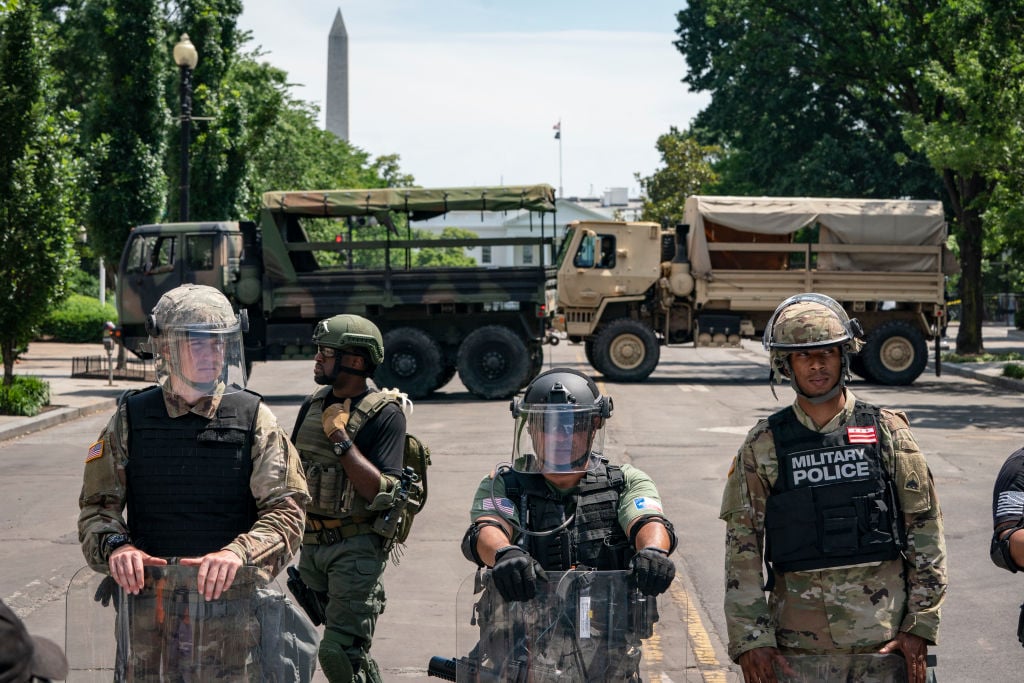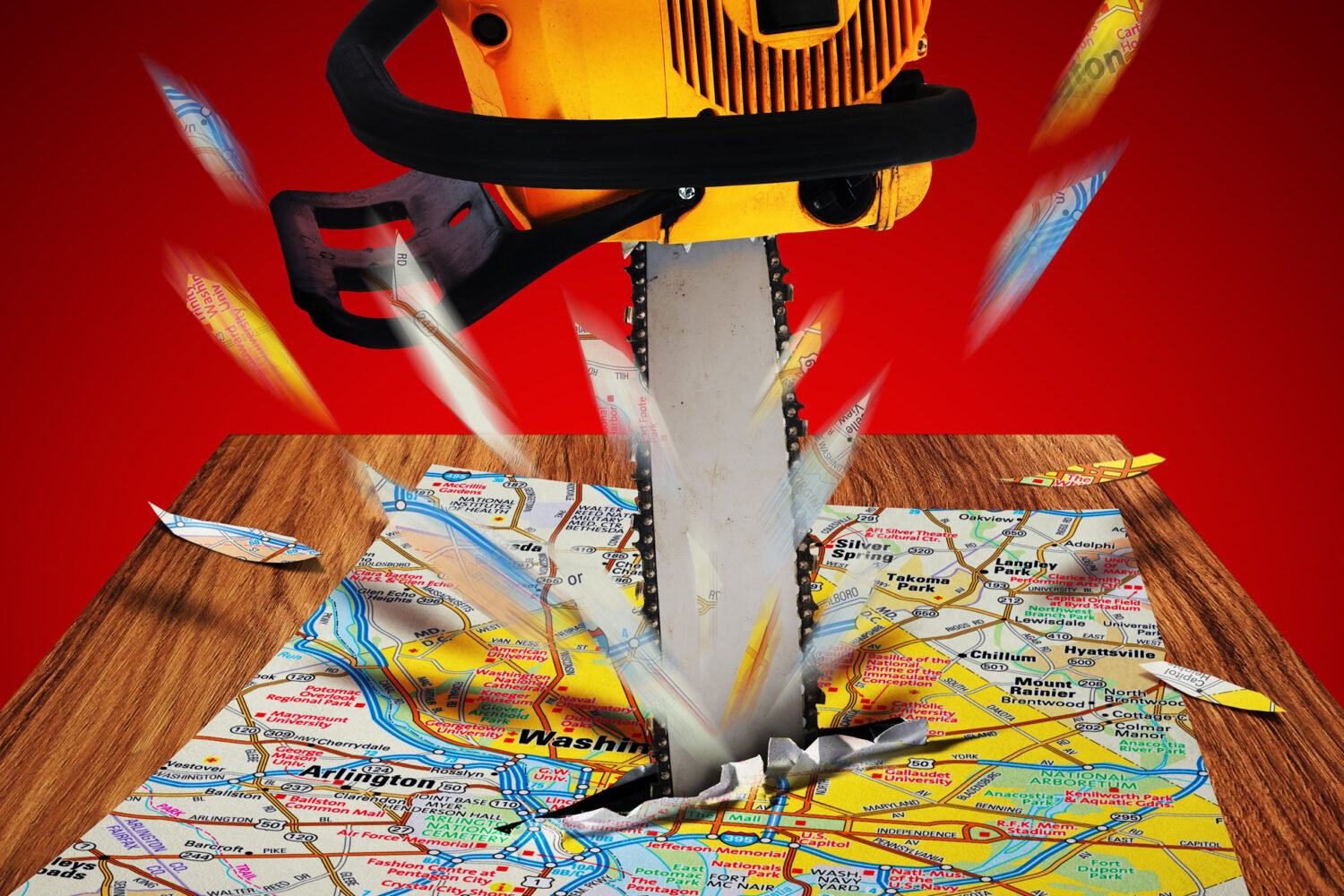Everyone knew Table 72 belonged to the President. The round booth in the middle of the Trump Hotel’s mezzanine was impossible to miss. It didn’t matter how many Congress members were clamoring for a reservation at the steakhouse or whether some tourist tried to slip a manager some cash (which they definitely did). No one sat at Trump’s table except the President, his children, and, occasionally, an approved member of his inner circle like Rudy Giuliani or Mike Pence.
In practical terms, the restaurant wanted to avoid the horror of turning away the leader of the free world if he happened to show up on a whim. But the seat also developed a kind of mystique. Sure, it may now be a relic in an underperforming venue. But for those four epic years, it was a carefully curated prop in the Trump Show.
And when the star appeared, you had to stick to the script. A “Standard Operating Procedure” document, recently obtained by Washingtonian, outlined step by step exactly what to do and what to say anytime Trump dined at BLT Prime, the hotel restaurant.
As soon as Trump was seated, the server had to “discreetly present” a mini bottle of Purell hand sanitizer. (This applied long before Covid, mind you.) Next, cue dialogue: “Good (time of day) Mr. President. Would you like your Diet Coke with or without ice?” the server was instructed to recite. A polished tray with chilled bottles and highball glasses was already prepared for either response. Directions for pouring the soda were detailed in a process no fewer than seven steps long—and illustrated with four photo exhibits. The beverage had to be opened in front of the germophobe commander in chief, “never beforehand.” The server was to hold a longneck-bottle opener by the lower third of the handle in one hand and the Diet Coke, also by the lower third, in the other. Once poured, the drink had to be placed at the President’s right-hand side. “Repeat until POTUS departs.”
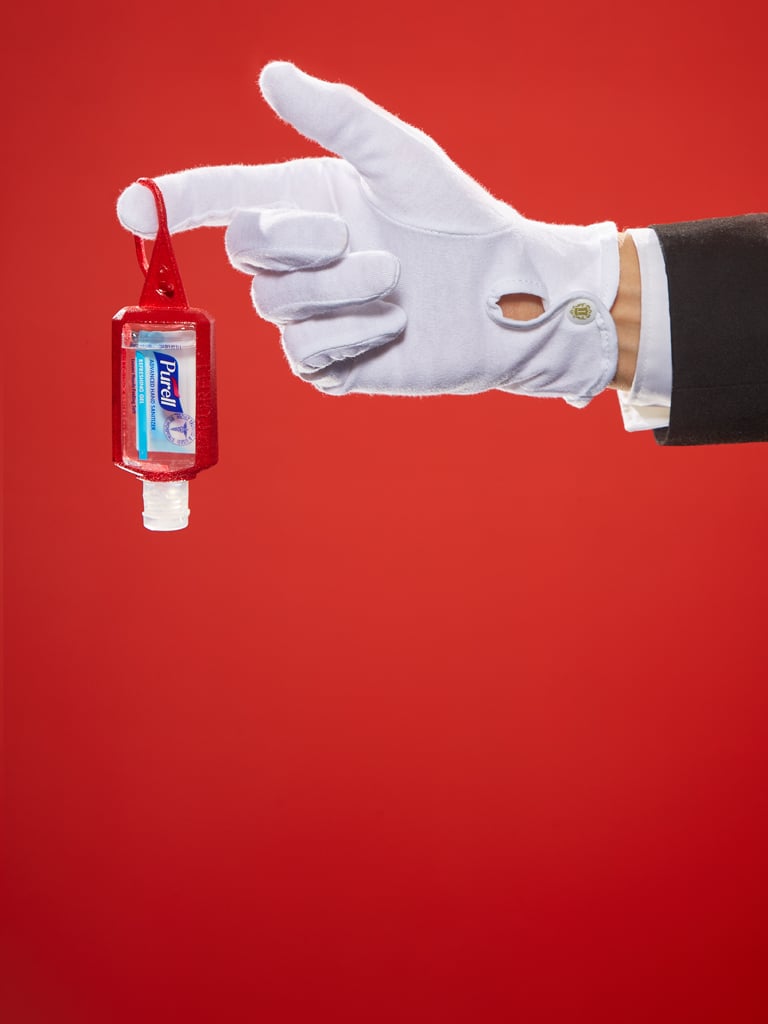
Trump always had the same thing: shrimp cocktail, well-done steak, and fries (plus sometimes apple pie or chocolate cake for dessert). Popovers—make it a double for the President—had to be served within two minutes and the crustaceans “immediately.” The manual instructed the server to open mini glass bottles of Heinz ketchup in front of Trump, taking care to ensure he could hear the seal make the “pop” sound.
Garnishes were a no-no. Melania Trump once sent back a Dover sole because it was dressed with parsley and chives, says former executive chef Bill Williamson, who worked at the restaurant until the start of the pandemic. Trump himself never returned a plate, but if he was disappointed, you can bet the complaint would travel down the ranks. Like the time the President questioned why his dining companion had a bigger steak. The restaurant already special-ordered super-sized shrimp just for him and no one else. Next time, they’d better beef up the beef.
“It was the same steak. Both well done. Maybe it was a half ounce bigger or something, I don’t know,” says Williamson, who had previously run the kitchens of DC staples Birch & Barley and the Riggsby. The chef had always prepared a bone-in rib eye or filet mignon for Trump. After Steakgate, he switched to a 40-ounce tomahawk. Trump would never again gripe that he didn’t have the greatest, hugest, most beautiful steak.
One more thing. Don’t forget the snacks. A tray of junk food needed to be available for every Trump visit: Lay’s potato chips (specifically, sour cream and onion), Milky Way, Snickers, Nature Valley Granola Bars, Tic Tacs, gummy bears, Chips Ahoy, Oreos, Nutter Butters, Tootsie Rolls, chocolate-covered raisins, and Pop-Secret.
The biggest pain in my butt was Giuliani.
The whole SOP reads like a pop star’s rider, which is apt for a place that served as center stage for the Trump drama and its entire cast of characters. Now, though, the Washington hotel is in the process of figuring out its next act. In 2019, the Trump Organization started trying to unload it for a reported $500 million—a number that industry pros reportedly balked at even before Covid devastated the hospitality world. Between the pandemic, Trump’s defeat, and the fallout from the US Capitol attack, the hotel’s cachet has plummeted since then. A financial disclosure released at the end of Trump’s presidency shows that the property took a 63-percent hit to its revenue in 2020.
If the hotel is ultimately sold, the new owner would likely start from scratch. And for the people who popped the ketchup and bussed the ungarnished plates, that means their jobs would be done. Well done.
But hey, it was a wild ride while it lasted!
Now veterans of the place are opening up about what it was really like behind the curtains of “America’s Living Room,” where right-wing operatives were treated like celebrities and political power determined the seating chart. If you weren’t in the business of Making America Great Again, well, sweetheart, you quickly learned to fake it. Working for the Trump hotel meant putting on a performance every night—right down to the gummy bears and popcorn.
First, always rehearse the night’s VIPs, a lineup that was as long and ever-changing as the President’s own roster of loyalists.
“Senators and cabinet members and all of their staffs and the President’s staff, important members of the Republican Party, megachurch pastors, MyPillow guy. He was a VIP, absolutely,” says former executive chef Shawn Matijevich. “The hotel would print us a book every day, if they were staying at the hotel, and it would have their pictures and their name and their job title.”
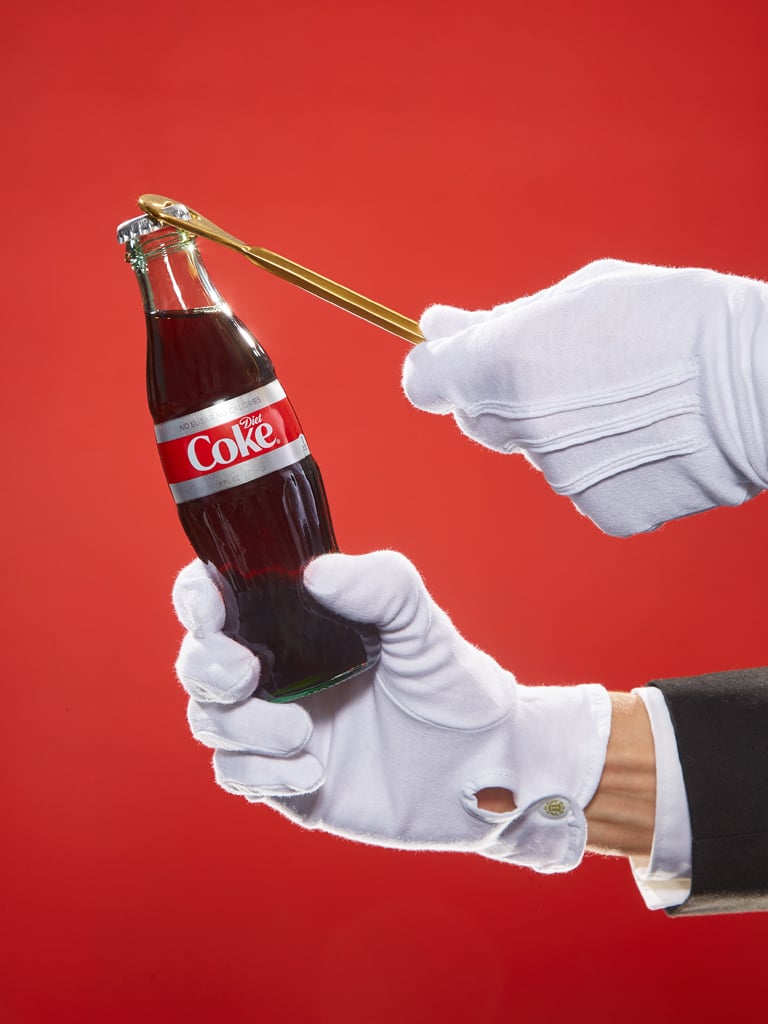
You had to know whom to suck up to—not always easy given the President’s Ferris wheel of allies. One time, before his break with Trump, attorney Michael Cohen tried to snag a table at BLT Prime without a reservation. The host didn’t know who he was and turned him away, leading the hotel’s managing director to scold the host’s supervisor. On another occasion, in the early days, the kitchen took forever with Hope Hicks’s order. She pulled the don’t-you-know-who-I-am card, letting the general manager know she was in fact Hope Hicks—you know, from the White House. The manager, who no longer works there, remembers apologizing profusely—then sending out a “dessert storm,” including a crepe soufflé and a cheesecake lollipop tree.
Another time, a busser’s apron got caught on the door of a private dining room, and he accidentally flung a ramekin full of steak sauce all over Arthur Schwartz, a GOP operative from New York who’s tight with Don Jr. The splatter just missed the President’s son.
“[Schwartz] came and cussed me out for a solid five, ten minutes, talking about how he was wearing a $10,000 suit,” the general manager says. “The hotel did pay for all the cleaning.” (Schwartz declined to comment.)
Perhaps the most notorious VIP was Rudy Giuliani, who had a regular table in the restaurant’s downstairs dining area. “It was pretty much his office. He was doing more paperwork there than eating,” Williamson, the chef, says. “Some days, he’d be there all day.” At one point, someone made it official and created a black-and-gold plaque that read RUDOLPH W. GIULIANI PRIVATE OFFICE. The restaurant would keep it behind the host stand and place it at his table before he arrived.

“The biggest pain in my butt was Giuliani,” says the former manager who dealt with an annoyed Hicks and a sauce-covered Schwartz (and who asked for anonymity to avoid blowback from future employers). “He was constantly in the restaurant. And I complained about it. The guy would come in, expect a table for ten at a moment’s notice at, like, 2 pm, when we’re not fully functioning. We don’t have the staff. But he’s the President’s lawyer, and what am I supposed to do?”
By contrast, Trump’s children were fairly low-key and polite. (The most salacious detail any former staff offered about Ivanka is that one time she showed up in yoga pants and indulged in a single margarita.) “They just came in, did their thing, and left,” says former assistant general manager Alyssa O’Clock. “Ivanka would sit with her back to the rest of the dining room. She didn’t really want to be seen there, necessarily.”
Tiffany also made occasional appearances for a mimosa-fueled brunch or a study break with Georgetown Law friends. Often, though, she was a no-show. “She made many reservations and didn’t show up for them for dinner,” a former manager says. “It was a pain.”
Catering to the right-wing bigwigs was less about showering them with freebies (although former White House chief of staff Mark Meadows and his wife might be greeted with complimentary bubbly) and more about highly customized service to feed their egos. The staff kept extensive notes on everyone who was anyone. For mega-philanthropist Catherine Reynolds, who was on Trump’s economic-revival council during the pandemic, diary-like records noted every preference down to how many olives she preferred in her martini. “I’ve worked in a few fine-dining places, but I’ve never worked somewhere where the VIP list was just so crazy,” O’Clock says. “There were a couple people where we had their entire order in our notes on OpenTable.”
Then there was lobbyist David Bockorny, a big Republican donor and Beltway operative since his days in the Reagan White House. He liked to get his morning coffee from the restaurant, but he’d show up before it was open. Instead of asking him to come later, “they decided we’ll just have coffee 15 minutes early because David Bockorny’s going to come,” O’Clock says. “Whoever was working those mornings knew: You need to be there on time, maybe a little bit early—this guy is coming in.”
Regulars such as Florida congressman Matt Gaetz and MyPillow CEO Mike Lindell were always around the lobby taking selfies with fans. In the restaurant, some top White House officials including Kellyanne Conway and Sarah Huckabee Sanders preferred more private booths in the back. But generally, the place to be was a table along the balcony rail on the mezzanine, overlooking the lobby and its soaring ceilings. That’s where you might spot Meadows, or American Conservative Union chairman Matt Schlapp, or then–Georgia senator Kelly Loeffler. Though if you didn’t have political pull, looks could get you there, too. “I was told to just put the pretty people on the rails one time,” says a former employee. “And the ones with Birkin bags.”
Treasury Secretary Steve Mnuchin and his wife, Louise Linton, who briefly lived in the hotel, were among the few allowed to occupy Trump’s table, sometimes with one of Linton’s purse-size pooches in tow, Paris Hilton–style. Their preferred Pinot Noir was also kept in stock even when it wasn’t on the menu. But not even they were immune to mishaps. During the 2017 inauguration, the staff had gotten crushed tending to the throng, then scrambled to find Marla Maples a table when she showed up without a res—so overwhelmed, in fact, that the restaurant lost Mnuchin’s coat.
“There were so many people in that hotel, and the hotel wasn’t ready to take all the coats, so we were trying to help out,” the former general manager says. Mnuchin, thankfully, wasn’t a jerk about it. “I’m pretty sure we found it a couple days later.”
The upper echelon of hotel management portrayed themselves as true Trump believers, but the majority of those who fed and cleaned up after the right-wing clientele were ambivalent at best. They clocked in because the place paid well. Really well. Michel Rivera, a former bartender at the lobby bar, says he pulled in more than $100,000 a year with tips (at least $30K more than he made at the Hay-Adams). He says it’s the best-paying job he’s had in his 25-year career, with generous health benefits to boot—a comment echoed by many other ex-employees.
“People would literally come up to me and give me $100 bills and be like, ‘You must be the best bartender in the world if you work here!’ ” Rivera says. “A group of three or four guys would come up, have a round of drinks—I could easily sell them over $1,000. You don’t see that at too many bars.” One restaurant manager says she’s never worked anyplace else where guests would so often try to grease her palm “like the old Mafia days,” angling for proximity to power. “I’d have people try to palm me to get closer to someone’s table, if a politician was in, or try to sit at Trump’s table, which is a big no-no,” she says. “I declined, obviously. I would get fired if we moved someone to Trump’s table.”
Anyone who wasn’t a Trump fan quickly learned that putting up a facade was part of the job. “I was lying. I said certain things to play the part and do what I needed to do in order to avoid problems,” Rivera says. “A lot of times, I would end up being like, ‘Yes, I support the President. He’s an amazing guy.’ ” One former manager recalls that when she started, another employee gave her a tour of the hotel, praising Trump for being “so good to the people” and “such a kind soul.” “I looked at them and was like, ‘You know what? You’re absolutely right,’ ” she says. “And inside I was dying.”
Behind the scenes, she and other Democrats on the payroll would groan when they learned the President was coming in: “It’s like, ‘Oh, great. I don’t want to have to deal with this. Can I get off early today? ’ ”
I always tried to dress like a Fox News anchor.
Maintaining appearances also meant literally maintaining appearances. Just as at other luxury hotels, the former President’s property has strict protocols for how employees should dress and look, down to the quarter-inch limit on men’s facial hair and the three-eighths-of-an-inch max on women’s fingernail length. According to its “Appearance & Grooming Policy,” obtained by Washingtonian, pants are technically permitted, but some female staff say there was an unspoken rule for attire: only dresses or skirts. “You’d get a disapproving look” otherwise, O’Clock says. “I just remember knowing anytime I wore pants: Oh, this is going to be a day. Make sure I have on a nice blazer and wear heels to balance out.” As a former female manager puts it: “I always tried to dress like a Fox News anchor.”
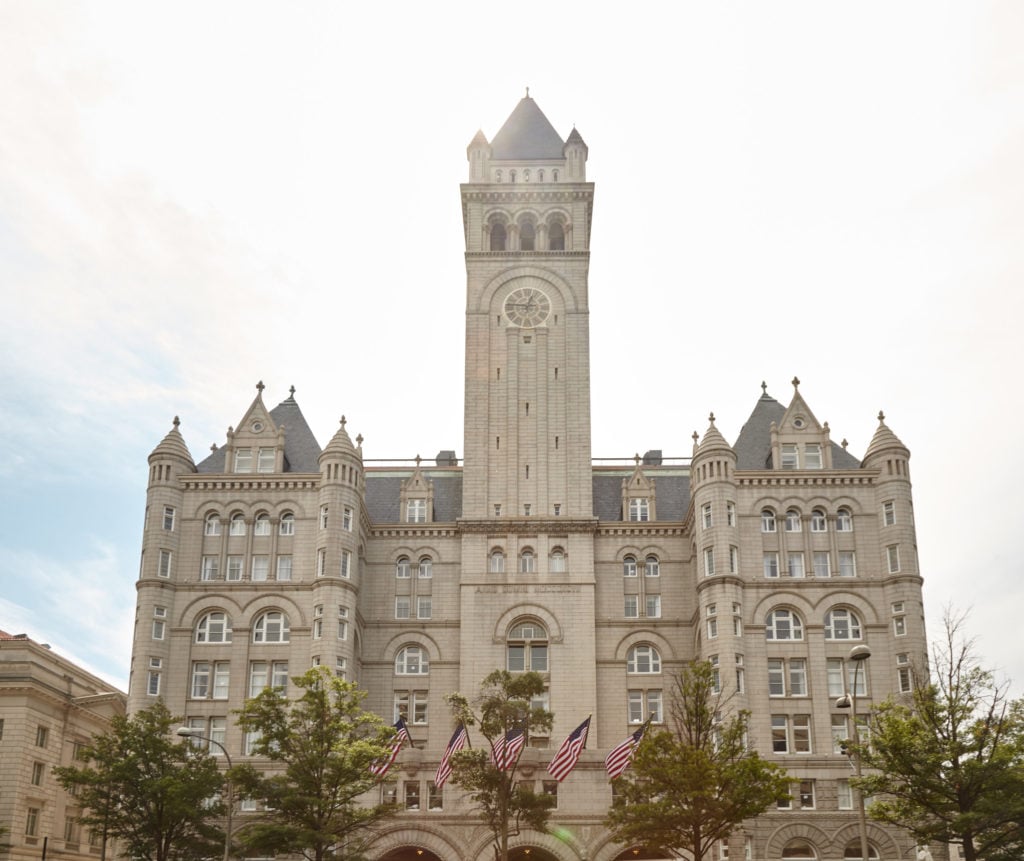
The expectations were intense, but this was the President’s hotel and everyone knew the press corps was watching. When Matijevich was chef, from October 2017 until he left eight months later to open his own restaurant in Norfolk, he says that a low tolerance for screwups led to a lot of firings, which often involved people being dramatically escorted out of the building: “I watched somebody get walked out for using bad language. We had to be on our best behavior every second that we were out there because somebody was waiting to notice that we made a mistake and it was going to be in the news.”
But as much as they worried about catching hell from bosses or patrons, some staff also were getting it from a different direction when they went home. “I’d say probably 80 to 90 percent of my kitchen staff was Hispanic,” Matijevich says. “A lot of people that worked there, their friends wouldn’t talk to them anymore. Some of the Hispanic workers, their family wouldn’t talk to them while they were working there, even their back-home family in other countries.”
A micro-green supplier that Matijevich had previously worked with ditched him, saying it couldn’t deliver to the hotel in good conscience. Williamson, who joined BLT in early 2018 and worked there two years, found that food purveyors with whom he’d had great relationships were suddenly sending him rotten produce and subpar cuts of meat and fish. “I had to double- and triple-check a lot of this product,” says Williamson, who now operates a boutique butcher shop in Mount Pleasant. “I guarantee someone in that warehouse picking this product saw where it was going and was like, ‘Oh, f— it, give ’em this stuff.’ ”
At a certain point, the disdain became too much even for one manager who was pro-Trump and loved the job. “We work every day—10, 12 hours—to make people happy with great food, and we have no [dining] coverage,” he says. When he took a break on the hotel terrace, joggers would give him the finger. One time, he says, he wore his uniform on the Metro to work and fellow passengers yelled at him, “Shame on you! How can you work for a person like that? You’re a racist!” He never commuted in uniform again. Eventually, he just didn’t want to deal with the harassment anymore. He left.
When Covid-19 shut everything down last spring, the restaurant laid off its entire workforce. But once indoor dining restrictions lifted, the lobby and steakhouse came alive again—and staff now had the added duty of trying to enforce safety protocols.
“I doubt as many restaurants in the city have to put up with grown men rolling their eyes when we ask them to put on their masks,” says one former employee. “The audacity of the comments and just the lack of human empathy, it shocked me. It made me want to go cry in the walk-in. People are dying and you’re joking about having to wear a mask.”
She says Rand Paul once used Scotch tape to secure his mask to his glasses, leaving it flapping over his mouth and nose. (Paul, who has decried mask mandates, was the first senator to contract Covid last year.) Says his communications director, Kelsey Cooper: “That story is not true.”
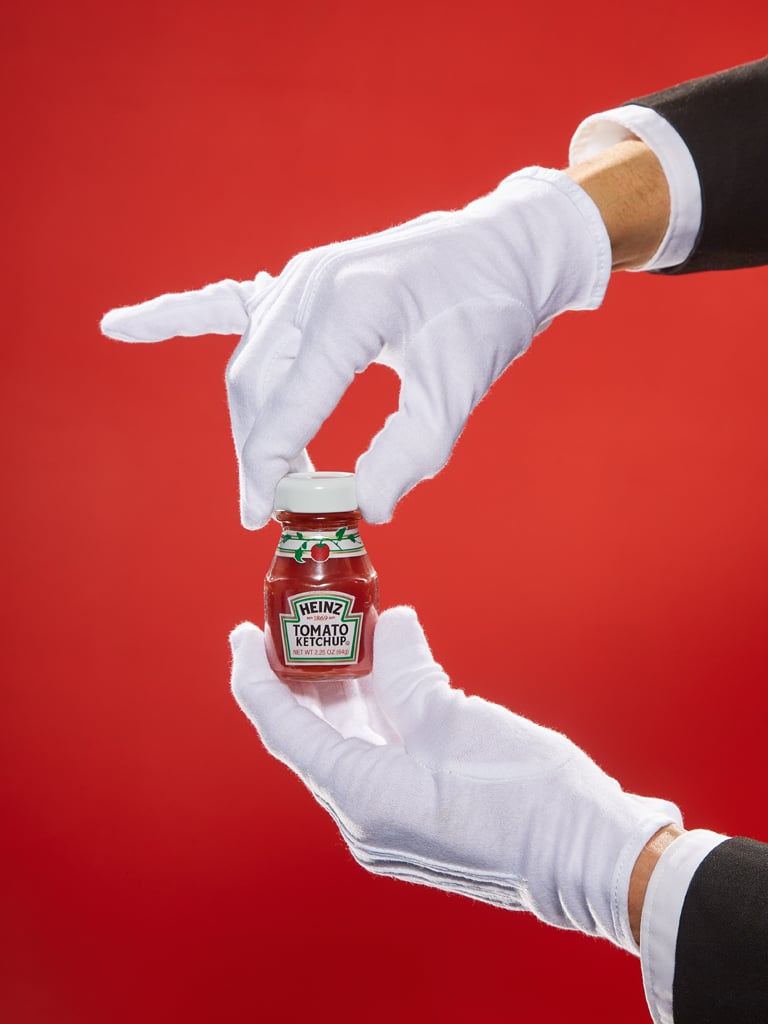
And multiple times, the employee says, the hotel management had to remind Dr. Scott Atlas, the Trump coronavirus adviser who pushed for letting the virus spread among the young and healthy in order to reach herd immunity, to wear his mask when he was walking around the lobby and not seated at a table. “That NEVER happened,” Atlas tells Washingtonian in an email. “I literally ALWAYS wore a mask there, 100 percent of the time unless I was seated at a table to eat or drink. That is yet another outrageous lie fabricated only to impugn me. Does the media ever get tired of lying?? You must really be desperate for a story, might be more interesting saying they have good food—please add this.”
Between pandemic restrictions and political turmoil leading up to November 3, the show at the hotel was no longer selling out. At times, security was tightened and no one was allowed inside without some kind of reservation. A lot of the same characters continued to come, but without the lobby schmoozing, the vibe wasn’t the same. Election week was bleak. “The guests, you could tell, were all very sad,” the employee says. “Behind closed doors, we were all celebrating that Biden’s going to win. But also, oh, God, we’re all going to probably have to find other jobs.”
Some talked about sticking it out through inauguration, but with Covid cases surging, indoor dining was banned again and many staff landed back on unemployment. Some worried that having the T-word on their résumés could get them blacklisted. (Rivera, the bartender, now lists his former employer only as “OPO” for Old Post Office.) And that was before the attack on the Capitol, the cabinet resignations, the second impeachment, and the defeated President’s helicopter ride into exile. Trump may have left Washington, but he still looms large over the hotel. Table 72 is there as a reminder—empty.
This article appears in the March 2021 issue of Washingtonian.





